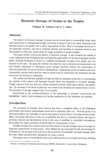Hermetic Storage of Grains in the Tropics
JIRCAS international symposium series
| ISSN | 13406108 |
|---|---|
| 書誌レコードID(総合目録DB) | AA1100908X |

本文フルテキスト
intlsymp-7_59-72.pdf436.78 KB
The history of hermetic storage of grains can be traced back to preneolithic times when man stored food in underground airtight structures to keep it free from insect infestation and likewise preserve its quality over a fairly long period of time. Man's increasing reluctance to use pesticides however, has led to renewed interest and incentive in pursuing research and development in this area, particularly for large quantities of grains handled.
This paper briefly reviews the history of hermetic storage. It also presents the results of trials conducted in the Philippines that evaluated the applicability of the use of gastight flexible plastic sheeting developed in Israel for modified and gastight storage of dry paddy and corn stacked in the open. By using the method, the objective was to develop environmentally and user-friendly temporary or emergency grain storage facilities without the requirement of chemical pesticides, for use by farmers' organizations, cooperatives, grain processors and other intermediary parties where security reserve stocks must be maintained, yet permanent storage structures are lacking or inadequate.
The studies showed that gastight storage provides an adequate protection by maintaining the number of live insects and damaged kernels below the threshold of economic damage. Weight losses in both rice and corn stacks remained minimal while seed viability was preserved. No increase in the level of aflatoxin was noted in the hermetically sealed stacks of corn. The duration of storage ranged from 3 to 6 months.
Experiences in the commercialization of the technology in farmers' cooperatives are highlighted. Lastly, future prospects for further application of the technique are outlined.
This paper briefly reviews the history of hermetic storage. It also presents the results of trials conducted in the Philippines that evaluated the applicability of the use of gastight flexible plastic sheeting developed in Israel for modified and gastight storage of dry paddy and corn stacked in the open. By using the method, the objective was to develop environmentally and user-friendly temporary or emergency grain storage facilities without the requirement of chemical pesticides, for use by farmers' organizations, cooperatives, grain processors and other intermediary parties where security reserve stocks must be maintained, yet permanent storage structures are lacking or inadequate.
The studies showed that gastight storage provides an adequate protection by maintaining the number of live insects and damaged kernels below the threshold of economic damage. Weight losses in both rice and corn stacks remained minimal while seed viability was preserved. No increase in the level of aflatoxin was noted in the hermetically sealed stacks of corn. The duration of storage ranged from 3 to 6 months.
Experiences in the commercialization of the technology in farmers' cooperatives are highlighted. Lastly, future prospects for further application of the technique are outlined.
| 作成者 | Filipinas M. Caliboso G. C. Sabio |
|---|---|
| 公開者 | Japan International Research Center for Agricultural Sciences |
| オンライン掲載日 | |
| 号 | 7 |
| 開始ページ | 59 |
| 終了ページ | 72 |
| 言語 | eng |
